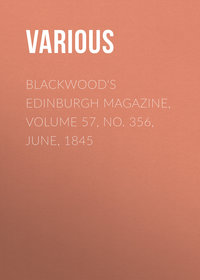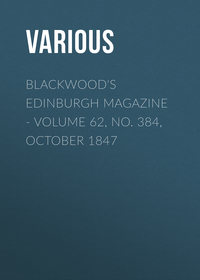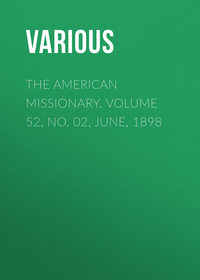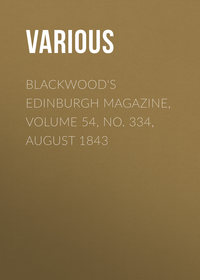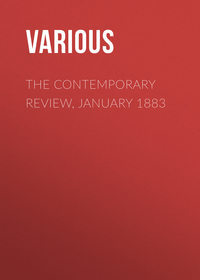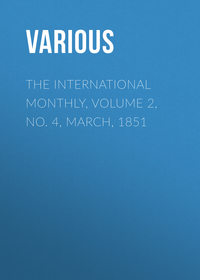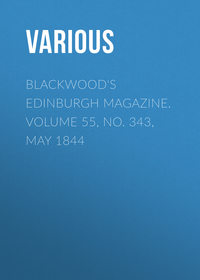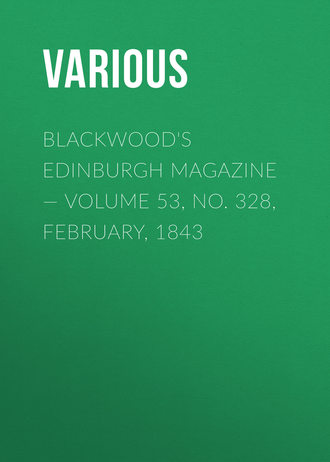 полная версия
полная версияBlackwood's Edinburgh Magazine — Volume 53, No. 328, February, 1843
The TENTH DISCOURSE.—Sir Joshua here treats of Sculpture, a less extensive field than Painting. The leading principles of both are the same; he considers wherein they agree, and wherein they differ. Sculpture cannot, "with propriety and best effect, be applied to many subjects." Its object is "form and character." It has "one style only,"—that one style has relation only to one style of painting, the Great Style, but that so close as to differ only as operating upon different materials. He blames the sculptors of the last age, who thought they were improving by borrowing from the ornamental, incompatible with its essential character. Contrasts, and the littlenesses of picturesque effects, are injurious to the formality its austere character requires. As in painting, so more particularly in sculpture, that imitation of nature which we call illusion, is in no respect its excellence, nor indeed its aim. Were it so, the Venus di Medici would be improved by colour. It contemplates a higher, a more perfect beauty, more an intellectual than sensual enjoyment. The boundaries of the art have been long fixed. To convey "sentiment and character, as exhibited by attitude, and expression of the passions," is not within its province. Beauty of form alone, the object of sculpture, "makes of itself a great work." In proof of which are the designs of Michael Angelo in both arts. As a stronger instance:— "What artist," says he, "ever looked at the Torso without feeling a warmth of enthusiasm as from the highest efforts of poetry? From whence does this proceed? What is there in this fragment that produces this effect, but the perfection of this science of abstract form?" Mr Burnet has given a plate of the Torso. The expectation of deception, of which few divest themselves, is an impediment to the judgment, consequently to the enjoyment of sculpture. "Its essence is correctness." It fully accomplishes its purpose when it adds the "ornament of grace, dignity of character, and appropriated expression, as in the Apollo, the Venus, the Laocoon, the Moses of Michael Angelo, and many others." Sir Joshua uses expression as will be afterwards seen, in a very limited sense. It is necessary to lay down perfect correctness as its essential character; because, as in the case of the Apollo, many have asserted the beauty to arise from a certain incorrectness in anatomy and proportion. He denies that there is this incorrectness, and asserts that there never ought to be; and that even in painting these are not the beauties, but defects, in the works of Coreggio and Parmegiano. "A supposition of such a monster as Grace begot by Deformity, is poison to the mind of a young artist." The Apollo and the Discobolus are engaged in the same purpose—the one watching the effect of his arrow, the other of his discus. "The graceful, negligent, though animated air of the one, and the vulgar eagerness of the other, furnish a signal instance of the skill of the ancient sculptors in their nice discrimination of character. They are both equally true to nature, and equally admirable." Grace, character, and expression, are rather in form and attitude than in features; the general figure more presents itself; "it is there we must principally look for expression or character; patuit in corpore vultus." The expression in the countenances of the Laocoon and his two sons, though greater than in any other antique statues, is of pain only; and that is more expressed "by the writhing and contortion of the body than by the features." The ancient sculptors paid but little regard to features for their expression, their object being solely beauty of form. "Take away from Apollo his lyre, from Bacchus his thyrsus and vine-leaves, and from Meleager the boar's head, and there will remain little or no difference in their characters." John di Bologna, he tells us, after he had finished a group, called his friends together to tell him what name to give it: they called it the "Rape of the Sabines." A similar anecdote is told of Sir Joshua himself, that he had painted the head of the old man who attended him in his studio. Some one observed that it would make a Ugolino. The sons were added, and it became the well-known historical picture from Dante. He comments upon the ineffectual attempts of modern sculptors to detach drapery from the figure, to give it the appearance of flying in the air; to make different plans on the same bas-relievos; to represent the effects of perspective; to clothe in a modern dress. For the first attempt he reprehends Bernini, who, from want of a right conception of the province of sculpture, never fulfilled the promise given in his early work of Apollo and Daphne. He was ever attempting to make drapery flutter in the air, which the very massiveness of the material, stone, should seem to forbid. Sir Joshua does not notice the very high authority for such an attempt—though it must be confessed the material was not stone, still it was sculpture, and multitudinous are the graces of ornament, and most minutely described—the shield of Hercules, by Hesiod; even the noise of the furies' wings is affected. The drapery of the Apollo he considers to have been intended more for support than ornament; but the mantle from the arm he thinks "answers a much higher purpose, by preventing that dryness of effect which would inevitably attend a naked arm, extended almost at full length; to which we may add, the disagreeable effect which would proceed from the body and arm making a right angle." He conjectures that Carlo Maratti, in his love for drapery, must have influenced the sculptors of the Apostles in the church of St John Lateran. "The weight and solidity of stone was not to be overcome."
To place figures on different plans is absurd, because they must still appear all equally near the eye; the sculptor has not adequate means of throwing them back; and, besides, the thus cutting up into minute parts, destroys grandeur. "Perhaps the only circumstance in which the modern have excelled the ancient sculptors, is the management of a single group in basso-relievo." This, he thinks, may have been suggested by the practice of modern painters. The attempt at perspective must, for the same reason, be absurd; the sculptor has not the means for this "humble ambition." The ancients represented only the elevation of whatever architecture they introduced into their bas-reliefs, "which is composed of little more than horizontal and perpendicular lines." Upon the attempt at modern dress in sculpture, he is severe in his censure. "Working in stone is a very serious business, and it seems to be scarce worth while to employ such durable materials in conveying to posterity a fashion, of which the longest existence scarcely exceeds a year;" and which, he might have added, the succeeding year makes ridiculous. We not only change our dresses, but laugh at the sight of those we have discarded. The gravity of sculpture should not be subject to contempt. "The uniformity and simplicity of the materials on which the sculptor labours, (which are only white marble,) prescribe bounds to his art, and teach him to confine himself to proportionable simplicity of design." Mr Burnet has not given a better note than that upon Sir Joshua's remark, that sculpture has but one style. He shows how strongly the ancient sculptors marked those points wherein the human figure differs from that of other animals. "Let us take, for example, the human foot; on examining, in the first instance, those of many animals, we perceive the toes either very long or very short in proportion; of an equal size nearly, and the claws often long and hooked inwards: now, in rude sculpture, and even in some of the best of the Egyptians, we find little attempt at giving a character of decided variation; but, on the contrary, we see the foot split up with toes of an equal length and thickness; while, in Greek sculpture, these points characteristic of man are increased, that the affinity to animals may be diminished. In the Greek marbles, the great toe is large and apart from the others, where the strap of the sandal came; while the others gradually diminish and sweep round to the outside of the foot, with the greatest regularity of curve; the nails are short, and the toes broad at the points, indicative of pressure on the ground." Rigidity he considers to have been the character of the first epochs, changing ultimately as in the Elgin marbles, "from the hard characteristics of stone to the vivified character of flesh." He thinks Reynolds "would have acknowledged the supremacy of beautiful nature, uncontrolled by the severe line of mathematical exactness," had he lived to see the Elgin marbles. "The outline of life, which changes under every respiration, seems to have undulated under the plastic mould of Phidias." This is well expressed. He justly animadverts upon the silly fashion of the day, in lauding the vulgar imitation of the worsted stockings by Thom. The subjects chosen were most unfit for sculpture,—their only immortality must be in Burns. We do not understand his extreme admiration of Wilkie; in a note on parallel perspective in sculpture, he adduces Raffaelle as an example of the practice, and closes by comparing him with Sir David Wilkie,—"known by the appellation of the Raffaelle of familiar life,"—men perfect antipodes to each other! There is a proper eulogy on Chantrey, particularly for his busts, in which he commonly represented the eye. We are most anxious for the arrival of the ancient sculpture from Lycia, collected and packed for Government by the indefatigable and able traveller, Mr Fellowes.
The ELEVENTH DISCOURSE is upon Genius, the particular genius of the painter in his power of seizing and representing nature, or his subject as a whole. He calls it the "genius of mechanical performance." This, with little difference, is enforcing what has been laid down in former Discourses. Indeed, as far as precepts may be required, Sir Joshua had already performed his task; hence, there is necessary repetition. Yet all is said well, and conviction perpetuates the impressions previously made. Character is something independent of minute detail; genius alone knows what constitutes this character, and practically to represent it, is to be a painter of genius. Though it be true that he "who does not at all express particulars expresses nothing; yet it is certain that a nice discrimination of minute circumstances, and a punctilious delineation of them, whatever excellence it may have, (and I do not mean to detract from it,) never did confer on the artist the character of genius." The impression left upon the mind is not of particulars, when it would seem to be so; such particulars are taken out of the subject, and are each a whole of themselves. Practically speaking, as we before observed, genius will be exerted in ascertaining how to paint the "nothing" in every picture, to satisfy with regard to detail, that neither its absence nor its presence shall be noticeable.
Our pleasure is not in minute imitation; for, in fact, that is not true imitation, for it forces upon our notice that which naturally we do not see. We are not pleased with wax-work, which may be nearer reality; "we are pleased, on the contrary, by seeing ends accomplished by seemingly inadequate means." If this be sound, we ought to be sensible of the inadequacy of the means, which sets aside at once the common notion that art is illusion. "The properties of all objects, as far as the painter is concerned with them, are outline or drawing, the colour, and the light and shade. The drawing gives the form, the colour its visible quality, and the light and shade its solidity:" in every one of these the habit of seeing as a whole must be acquired. From this habit arises the power of imitating by "dexterous methods." He proceeds to show that the fame of the greatest painters does not rest upon their high finish. Raffaelle and Titian, one in drawing the other in colour, by no means finished highly; but acquired by their genius an expressive execution. Most of his subsequent remarks are upon practice in execution and colour, in contradistinction to elaborate finish. Vasari calls Titian, "giudicioso, bello, e stupendo," with regard to this power. He generalized by colour, and by execution. "In his colouring, he was large and general." By these epithets, we think Sir Joshua has admitted that the great style comprehends colouring. "Whether it is the human figure, an animal, or even inanimate objects, there is nothing, however unpromising in appearance, but may be raised into dignity, convey sentiment, and produce emotion, in the hands of a painter of genius." He condemns that high finish which softens off. "This extreme softening, instead of producing the effect of softness, gives the appearance of ivory, or some other hard substance, highly polished. The value set upon drawings, such as of Coreggio and Parmegiano, which are but slight, show how much satisfaction can be given without high finishing, or minute attention to particulars. "I wish you to bear in mind, that when I speak of a whole, I do not mean simply a whole as belonging to composition, but a whole with respect to the general style of colouring; a whole with regard to light and shade; and a whole of every thing which may separately become the main object of a painter. He speaks of a landscape painter in Rome, who endeavoured to represent every individual leaf upon a tree; a few happy touches would have given a more true resemblance. There is always a largeness and a freedom in happy execution, that finish can never attain. Sir Joshua says above, that even "unpromising" subjects may be thus treated. There is a painter commonly thought to have finished highly, by those who do not look into his manner, whose dexterous, happy execution was perhaps never surpassed; the consequence is, that there is "a largeness," in all his pictures. We mean Teniers. The effect of the elaborate work that has been added to his class of subjects, is to make them heavy and fatiguing to the eye. He praises Titian for the same large manner which he had given to his history and portraits, applied to his landscapes, and instances the back-ground to the "Peter Martyr." He recommends the same practice in portrait painting—the first thing to be attained, is largeness and general effect. The following puts the truth clearly. "Perhaps nothing that we can say will so clearly show the advantage and excellence of this faculty, as that it confers the character of genius on works that pretend to no other merit, in which is neither expression, character, nor dignity, and where none are interested in the subject. We cannot refuse the character of genius to the 'Marriage' of Paolo Veronese, without opposing the general sense of mankind, (great authorities have called it the triumph of painting,) or to the Altar of St Augustine at Antwerp, by Rubens, which equally deserves that title, and for the same reason. Neither of these pictures have any interesting story to support them. That of Paolo Veronese is only a representation of a great concourse of people at a dinner; and the subject of Rubens, if it may be called a subject where nothing is doing, is an assembly of various saints that lived in different ages. The whole excellence of those pictures consists in mechanical dexterity, working, however, under the influence of that comprehensive faculty which I have so often mentioned."
The power of a whole is exemplified by the anecdote of a child going through a gallery of old portraits. She paid very little attention to the finishing, or naturalness of drapery, but put herself at once to mimic the awkward attitudes. "The censure of nature uninformed, fastened upon the greatest fault that could be in a picture, because it related to the character and management of the whole." What he would condemn is that substitute for deep and proper study, which is to enable the painter to conceive and execute every subject as a whole, and a finish which Cowley calls "laborious effects of idleness." He concludes this Discourse with some hints on method of study. Many go to Italy to copy pictures, and derive little advantage. "The great business of study is, to form a mind adapted and adequate to all times and all occasions, to which all nature is then laid open, and which may be said to possess the key of her inexhaustible riches."
Mr Burnet has supplied a plate of the Monk flying from the scene of murder, in Titian's "Peter Martyr," showing how that great painter could occasionally adopt the style of Michael Angelo in his forms. In the same note he observes, that Sir Joshua had forgotten the detail of this picture, which detail is noticed and praised by Algarotti, for its minute discrimination of leaves and plants, "even to excite the admiration of a botanist."—Sir Joshua said they were not there. Mr Burnet examined the picture at Paris, and found, indeed, the detail, but adds, that "they are made out with the same hue as the general tint of the ground, which is a dull brown," an exemplification of the rule, "Ars est celare artem." Mr Burnet remarks, that there is the same minute detail in Titian's "Bacchus and Ariadne."—He is right—we have noticed it, and suspected that it had lost the glazing which had subdued it. As it is, however, it is not important. Mr Burnet is fearful lest the authority of Sir Joshua should induce a habit of generalizing too much. He expresses this fear in another note. He says, "the great eagerness to acquire what the poet calls
'That voluntary style, Which careless plays, and seems to mock at toil,'and which Reynolds describes as so captivating, has led many a student to commence his career at the wrong end. They ought to remember, that even Rubens founded this excellence upon years of laborious and careful study. His picture of himself and his first wife, though the size of life, exhibits all the detail and finish of Holbein." Sir Joshua nowhere recommends careless style; on the contrary, he every where urges the student to laborious toil, in order that he may acquire that facility which Sir Joshua so justly calls captivating, and which afterwards Rubens himself did acquire, by studying it in the works of Titian and Paul Veronese; and singularly, in contradiction to his fears and all he would imply, Mr Burnet terminates his passage thus:—"Nor did he (Rubens) quit the dry manner of Otho Venius, till a contemplation of the works of Titian and Paul Veronese enabled him to display with rapidity those materials which industry had collected." It is strange to argue upon the abuse of a precept, by taking it at the wrong end.
The TWELFTH DISCOURSE recurs likewise to much that had been before laid down. It treats of methods of study, upon which he had been consulted by artists about to visit Italy. Particular methods of study he considers of little consequence; study must not be shackled by too much method. If the painter loves his art, he will not require prescribed tasks;—to go about which sluggishly, which he will do if he have another impulse, can be of little advantage. Hence would follow, as he admirably expresses it, "a reluctant understanding," and a "servile hand." He supposes, however, the student to be somewhat advanced. The boy, like other school-boys, must be under restraint, and learn the "Grammar and Rudiments" laboriously. It is not such who travel for knowledge. The student, he thinks, may be pretty much left to himself; if he undertake things above his strength, it is better he should run the risk of discouragement thereby, than acquire "a slow proficiency" by "too easy tasks." He has little confidence in the efficacy of method, "in acquiring excellence in any art whatever." Methodical studies, with all their apparatus, enquiry, and mechanical labour, tend too often but "to evade and shuffle off real labour—the real labour of thinking." He has ever avoided giving particular directions. He has found students who have imagined they could make "prodigious progress under some particular eminent master." Such would lean on any but themselves. "After the Rudiments are past, very little of our art can be taught by others." A student ought to have a just and manly confidence in himself, "or rather in the persevering industry which he is resolved to possess." Raffaelle had done nothing, and was quite young, when fixed upon to adorn the Vatican with his works; he had even to direct the best artists of his age. He had a meek and gentle disposition, but it was not inconsistent with that manly confidence that insured him success—a confidence in himself arising from a consciousness of power, and a determination to exert it. The result is "in perpetuum."—There are, however, artists who have too much self-confidence, that is ill-founded confidence, founded rather upon a certain dexterity than upon a habit of thought; they are like the improvisatori in poetry; and most commonly, as Metastasio acknowledged of himself, had much to unlearn, to acquire a habit of thinking with selection. To be able to draw and to design with rapidity, is, indeed, to be master of the grammar of art; but in the completion, and in the final settlement of the design, the portfolio must again and again have been turned over, and the nicest judgment exercised. This judgment is the result of deep study and intenseness of thought—thought not only upon the artist's own inventions, but those of others. Luca Giordano and La Fage are brought as examples of great dexterity and readiness of invention—but of little selection; for they borrowed very little from others: and still less will any artist, that can distinguish between excellence and insipidity, ever borrow from them. Raffaelle, who had no lack of invention, took the greatest pains to select; and when designing "his greatest as well as latest works, the Cartoons," he had before him studies he had made from Masaccio. He borrowed from him "two noble figures of St Paul." The only alteration he made was in the showing both hands, which he thought in a principal figure should never be omitted. Masaccio's work was well known; Raffaelle was not ashamed to have borrowed. "Such men, surely, need not be ashamed of that friendly intercourse which ought to exist among artists, of receiving from the dead, and giving to the living, and perhaps to those who are yet unborn. The daily food and nourishment of the mind of an artist is found in the great works of his predecessors. 'Serpens nisi serpentem comederit, non fit draco.'" The fact is, the most self-sufficient of men are greater borrowers than they will admit, or perhaps know; their very novelties, if they have any, commence upon the thoughts of others, which are laid down as a foundation in their own minds. The common sense, which is called "common property," is that stock which all that have gone before us have left behind them; and we are but admitted to the heirship of what they have acquired. Masaccio Sir Joshua considers to have been "one of the great fathers of modern art." He was the first who gave largeness, and "discovered the path that leads to every excellence to which the art afterwards arrived." It is enough to say of him, that Michael Angelo, Leonardo da Vinci, Pietro Perugino, Raffaelle, Bartolomeo, Andrea del Sarto, Il Rosso, and Pierino del Vaga, formed their taste by studying his works. "An artist-like mind" is best formed by studying the works of great artists. It is a good practice to consider figures in works of great masters as statues which we may take in any view. This did Raffaelle, in his "Sergius Paulus," from Masaccio. Lest there should be any misunderstanding of this sort of borrowing, which he justifies, he again refers to the practice of Raffaelle in this his borrowing from Masaccio. The two figures of St Paul, he doubted if Raffaelle could have improved; but "he had the address to change in some measure without diminishing the grandeur of their character." For a serene composed dignity, he has given animation suited to their employment. "In the same manner, he has given more animation to the figure of Sergius Paulus, and to that which is introduced in the picture of Paul preaching, of which little more than hints are given by Masaccio, which Raffaelle has finished. The closing the eyes of this figure, which in Masaccio might be easily mistaken for sleeping, is not in the least ambiguous in the Cartoon. His eyes, indeed are closed, but they are closed with such vehemence, that the agitation of a mind perplexed in the extreme is seen at the first glance; but what is most extraordinary, and I think particularly to be admired, is, that the same idea is continued through the whole figure, even to the drapery, which is so closely muffled about him, that even his hands are not seen: By this happy correspondence between the expression of the countenance and the disposition of the parts, the figure appears to think from head to foot. Men of superior talents alone are capable of thus using and adapting other men's minds to their own purposes, or are able to make out and finish what was only in the original a hint or imperfect conception. A readiness in taking such hints, which escape the dull and ignorant, makes, in my opinion, no inconsiderable part of that faculty of mind which is called genius." He urges the student not even to think himself qualified to invent, till he is well acquainted with the stores of invention the world possesses; and insists that, without such study, he will not have learned to select from nature. He has more than once enforced this doctrine, because it is new. He recommends, even in borrowing, however, an immediate recurrence to the model, that every thing may be finished from nature. Hence he proceeds to give some directions for placing the model and the drapery—first to impress upon the model the purpose of the attitude required—next, to be careful not to alter drapery with the hand, rather trusting, if defective, to a new cast. There is much in being in the way of accident. To obtain the freedom of accident Rembrandt put on his colours with his palette-knife; a very common practice at the present day. "Works produced in an accidental manner will have the same free unrestrained air as the works of nature, whose particular combinations seem to depend upon accident." He concludes this Discourse by more strenuously insisting upon the necessity of ever having nature in view—and warns students by the example of Boucher, Director of the French Academy, whom he saw working upon a large picture, "without drawings or models of any kind." He had left off the use of models many years. Though a man of ability, his pictures showed the mischief of his practice. Mr Burnet's notes to this Discourse add little to the material of criticism; they do but reiterate in substance what Sir Joshua had himself sufficiently repeated. His object seems rather to seize an opportunity of expressing his admiration of Wilkie, whom he adduces as a parallel example with Raffaelle of successful borrowing. It appears from the account given of Wilkie's process, that he carried the practice much beyond Raffaelle. We cannot conceive any thing very good coming from so very methodical a manner of setting to work. Would not the fire of genius be extinguished by the coolness of the process? "When he had fixed upon his subject, he thought upon all pictures of that class already in existence." The after process was most elaborate. Now, this we should think a practice quite contrary to Raffaelle's, who more probably trusted to his own conception for the character of his picture as a whole, and whose borrowing was more of single figures; but, if of the whole manner of treating his subject, it is not likely that he would have thought of more than one work for his imitation. The fact is, Sir David Wilkie's pictures show that he did carry this practice too far—for there is scarcely a picture of his that does not show patches of imitations, that are not always congruous with each other; there is too often in one piece, a bit of Rembrandt, a bit of Velasquez, a bit of Ostade, or others. The most perfect, as a whole, is his "Chelsea Pensioners." We do not quite understand the brew of study fermenting an accumulation of knowledge, and imagination exalting it. "An accumulation of knowledge impregnated his mind, fermented by study, and exalted by imagination;" this is very ambitious, but not very intelligible. He speaks of Wilkie attracting the attention of admirers and detractors. It is very absurd to consider criticism that is not always favourable, detraction. The following passage is well put. "We constantly hear the ignorant advising a student to study the great book of nature, without being biassed by what has been done by other painters; it is as absurd as if they would recommend a youth to learn astronomy by lying in the fields, and looking on the stars, without reference to the works of Kepler, Tycho Brahe, or of Newton." There is indeed a world of cant in the present day, that a man must do all to his own unprejudiced reason, contemning all that has been done before him. We have just now been looking at a pamphlet on Materialism (a pamphlet of most ambitious verbiage,) in which, with reference to all former education, we are "the slaves of prejudice;" yet the author modestly requires that minds—we beg his pardon, we have no minds—intellects must be trained to his mode of thinking, ere they can arrive at the truth and the perfection of human nature. If this training is prejudice in one set of teachers, may it not be in another? We continually hear artists recommend nature without "a prejudice in favour of old masters." Such artists are not likely to eclipse the fame of those great men, the study of whose works has so long prejudiced the world.


